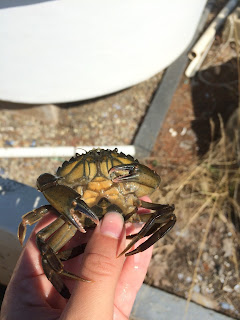Hi Everyone!
It’s been a busy summer so far! During the past
few weeks I've been continuing to work on both the green crab project and the
integrated multi trophic aquaculture project, while also diving into other
projects such as a micro plastics monitoring project and a cleanup on Appledore
Island. This fellowship has given me the opportunity to learn so much
about different sampling methods as well as different experiment approaches.
Now for the green crab update! So far only one
green crab has molted that was not in our experimental group. It was really
cool to see the crab just after it had molted - it was very soft and red.
However, in just 24 hours the crab already had a fairly hard shell, and after
48 hours the crab had an even firmer shell that was completely green in color!
Since the crab becomes firm so quickly, they would need to be flash frozen
within the first day of their molting.
|
|
We are continuing to monitor the crabs in our
initial group, but since the crabs haven't molted within the month, we decided
to collect a new group and begin the experiment again with new crabs in a
separate tank. We made our second group smaller, with 10 control female crabs
and 10 experimental (scratched) female crabs because we discovered that working
with and observing 50 crabs was too difficult. For this project, it was
especially difficult since we need to document and observe morphological
features of all crabs in our experiment. Hopefully our second round of the
experiment will go more smoothly than our first! We had a few bumps in the road
regarding tagging and identification, tank set up and maintenance, crabs
becoming gravid and mortality. Working through all of these issues has taught
me a lot about the scientific process and thinking outside the box to problem
solve.
 |
| Mussel line with collected spat from last fall |
 |
| New mussel line |
Rozalia Project Group and I on Appledore preparing for the clean up
|
Lastly, I've had the opportunity these past couple weeks to work with Gabby Bradt on her micro plastics monitoring project as well as a clean up on Appledore Island! For the monitoring project, samples are collected at the 5 most at risk beaches in New Hampshire (Jenness, Hampton Harbor, Hampton Beach, North Hampton Beach, and Wallis Sands) each month and processed by categorizing any plastic found. Quadrats are set up at the rack line on the beach and sand is run through a series of sieves, down to 1mm. Any plastic is collected from the larger sieves, while all other remnants are left on the beach. After going through the final sieve, all remnants are saved and looked at under a microscope later for categorizing. It was fun to clean up the beach a little, while collecting data so that we will be able to see a trend in the types of plastics found and their distribution.
 |
| Cleaning up the shoreline of Appledore Island (note the buoys in the center of the picture) |
We also did some plastic clean up on Appledore Island, but instead of micro plastics we were looking for large plastic debris. We spent the day working with a high school group taking a 2-week course on the island, as well as a group working with the Rozalia Project for a Clean Ocean. What was most surprising to me was that the majority of the plastic trash we found was fishing gear; fishing lines, buoys, lobster traps, ropes, and large bits of Styrofoam. Since Appledore is so remote, I had the idea that there actually wouldn’t be very much trash or plastic to pick up.
However, I quickly saw that this was not the case!
However, I quickly saw that this was not the case!
I’m very eager to continue working with both Michael and Gabby on all of these projects and more opportunities to come! This summer has been an absolute blast so far and it’s coming to an end too quickly. Be on the look out for another update coming soon.







